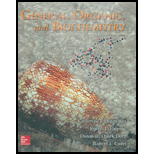
Concept explainers
(a)
Interpretation:
The given equation
Concept Introduction:
Balancing the equation:
- There is a Law for conversion of mass in a
chemical reaction i.e., the mass of total amount of the product should be equal to the total mass of the reactants. - First write the skeletal reaction from the given information.
- Then count the number of atoms of each element in reactants as well as products.
- Place suitable coefficients in front of reactants as well as products until the number of atoms on each side (reactants and products) becomes equal.
(a)
Explanation of Solution
Given equation:
Balancing the chemical Equation:
Count the number of atoms on each side of the reaction.
| Atom | Reactant side | Product side |
| 10 | 2 | |
| 2 | 3 | |
| 4 | 1 |
Place suitable coefficient before reactants and products and then check for the number of atoms again.
| Atom | Reactant side | Product side |
| 20 | 20 | |
| 26 | 26 | |
| 8 | 8 |
The number of atoms of present on each side of the reaction is same. Hence, the balanced equation for the given reaction is
(b)
Interpretation:
The given equation
Concept Introduction:
Refer part (a)
(b)
Explanation of Solution
Given equation:
Balancing the chemical Equation:
Count the number of atoms on each side of the reaction.
| Atom | Reactant side | Product side |
| 2 | 1 | |
| 3 | 1 | |
| 2 | 2 |
Place suitable coefficient before reactants and products and then check for the number of atoms again.
| Atom | Reactant side | Product side |
| 2 | 2 | |
| 3 | 3 | |
| 6 | 6 |
The number of atoms of present on each side of the reaction is same. Hence, the balanced equation for the given reaction is
(c)
Interpretation:
The given equation
Concept Introduction:
Refer part (a)
(c)
Explanation of Solution
Given equation:
Balancing the chemical Equation:
Count the number of atoms on each side of the reaction.
| Atom | Reactant side | Product side |
| 1 | 1 | |
| 3 | 1 | |
| 4 | 2 | |
| 1 | 3 |
Place suitable coefficient before reactants and products and then check for the number of atoms again.
| Atom | Reactant side | Product side |
| 1 | 1 | |
| 3 | 3 | |
| 6 | 6 | |
| 3 | 3 |
The number of atoms of present on each side of the reaction is same. Hence, the balanced equation for the given reaction is
(d)
Interpretation:
The given equation
Concept Introduction:
Refer part (a)
(d)
Explanation of Solution
Given reaction:
Balancing the chemical Equation:
Count the number of atoms on each side of the reaction.
| Atom | Reactant side | Product side |
| 2 | 2 | |
| 8 | 2 | |
| 2 | 2 | |
| 7 | 4 |
Place suitable coefficient before reactants and products and then check for the number of atoms again.
| Atom | Reactant side | Product side |
| 2 | 2 | |
| 8 | 8 | |
| 2 | 2 | |
| 7 | 7 |
The number of atoms of present on each side of the reaction is same. Hence, the balanced equation for the given reaction is
Want to see more full solutions like this?
Chapter 4 Solutions
GENERAL,ORGANIC,+BIOCHEM.(LL) >CUSTOM<
- Can I please get help with this?arrow_forwardUse the Henderson-Hasselbalch equation to calculate pH of a buffer containing 0.050M benzoic acidand 0.150M sodium benzoate. The Ka of benzoic acid is 6.5 x 10-5arrow_forwardA. Draw the structure of each of the following alcohols. Then draw and name the product you would expect to produce by the oxidation of each. a. 4-Methyl-2-heptanol b. 3,4-Dimethyl-1-pentanol c. 4-Ethyl-2-heptanol d. 5,7-Dichloro-3-heptanolarrow_forward
- What is the pH of a 1.0 L buffer made with 0.300 mol of HF (Ka = 6.8 × 10⁻⁴) and 0.200 mol of NaF to which 0.160 mol of NaOH were added?arrow_forwardCan I please get help with this.arrow_forwardDetermine if the following salt is neutral, acidic or basic. If acidic or basic, write the appropriate equilibrium equation for the acid or base that exists when the salt is dissolved in aqueous solution. If neutral, simply write only NR. Be sure to include the proper phases for all species within the reaction. N₂H₅ClO₄arrow_forward
 ChemistryChemistryISBN:9781305957404Author:Steven S. Zumdahl, Susan A. Zumdahl, Donald J. DeCostePublisher:Cengage Learning
ChemistryChemistryISBN:9781305957404Author:Steven S. Zumdahl, Susan A. Zumdahl, Donald J. DeCostePublisher:Cengage Learning ChemistryChemistryISBN:9781259911156Author:Raymond Chang Dr., Jason Overby ProfessorPublisher:McGraw-Hill Education
ChemistryChemistryISBN:9781259911156Author:Raymond Chang Dr., Jason Overby ProfessorPublisher:McGraw-Hill Education Principles of Instrumental AnalysisChemistryISBN:9781305577213Author:Douglas A. Skoog, F. James Holler, Stanley R. CrouchPublisher:Cengage Learning
Principles of Instrumental AnalysisChemistryISBN:9781305577213Author:Douglas A. Skoog, F. James Holler, Stanley R. CrouchPublisher:Cengage Learning Organic ChemistryChemistryISBN:9780078021558Author:Janice Gorzynski Smith Dr.Publisher:McGraw-Hill Education
Organic ChemistryChemistryISBN:9780078021558Author:Janice Gorzynski Smith Dr.Publisher:McGraw-Hill Education Chemistry: Principles and ReactionsChemistryISBN:9781305079373Author:William L. Masterton, Cecile N. HurleyPublisher:Cengage Learning
Chemistry: Principles and ReactionsChemistryISBN:9781305079373Author:William L. Masterton, Cecile N. HurleyPublisher:Cengage Learning Elementary Principles of Chemical Processes, Bind...ChemistryISBN:9781118431221Author:Richard M. Felder, Ronald W. Rousseau, Lisa G. BullardPublisher:WILEY
Elementary Principles of Chemical Processes, Bind...ChemistryISBN:9781118431221Author:Richard M. Felder, Ronald W. Rousseau, Lisa G. BullardPublisher:WILEY





